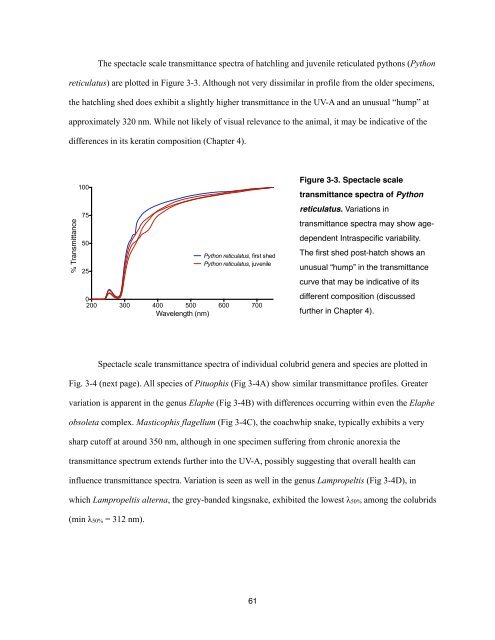Chapter 1, The Reptilian Spectacle - UWSpace - University of ...
Chapter 1, The Reptilian Spectacle - UWSpace - University of ...
Chapter 1, The Reptilian Spectacle - UWSpace - University of ...
Create successful ePaper yourself
Turn your PDF publications into a flip-book with our unique Google optimized e-Paper software.
% Transmission<br />
% Transmittance<br />
<strong>The</strong> spectacle scale transmittance spectra <strong>of</strong> hatchling and juvenile reticulated pythons (Python<br />
reticulatus) are plotted in Figure 3-3. Although not very dissimilar in pr<strong>of</strong>ile from the older specimens,<br />
the hatchling shed does exhibit a slightly higher transmittance in the UV-A and an unusual “hump” at<br />
approximately 320 nm. While not likely <strong>of</strong> visual relevance to the animal, it may be indicative <strong>of</strong> the<br />
differences in its keratin composition (<strong>Chapter</strong> 4).<br />
100<br />
75<br />
50<br />
25<br />
Figure 3-3. <strong>Spectacle</strong> scale<br />
transmittance spectra <strong>of</strong> Python<br />
reticulatus. Variations in<br />
transmittance spectra may show age-<br />
dependent Intraspecific variability.<br />
<strong>The</strong> first shed post-hatch shows an<br />
unusual “hump” in the transmittance<br />
curve that may be indicative <strong>of</strong> its<br />
different composition (discussed<br />
further in <strong>Chapter</strong> 4).<br />
<strong>Spectacle</strong> scale transmittance spectra <strong>of</strong> individual colubrid genera and species are plotted in<br />
Fig. 3-4 (next page). All species <strong>of</strong> Pituophis (Fig 3-4A) show similar transmittance pr<strong>of</strong>iles. Greater<br />
variation is apparent in the genus Elaphe (Fig 3-4B) with differences occurring within even the Elaphe<br />
obsoleta complex. Masticophis flagellum (Fig 3-4C), the coachwhip snake, typically exhibits a very<br />
sharp cut<strong>of</strong>f at around 350 nm, although in one specimen suffering from chronic anorexia the<br />
transmittance spectrum extends further into the UV-A, possibly suggesting that overall health can<br />
influence transmittance spectra. Variation is seen as well in the genus Lampropeltis (Fig 3-4D), in<br />
which Lampropeltis alterna, the grey-banded kingsnake, exhibited the lowest λ50% among the colubrids<br />
(min λ50% = 312 nm).<br />
<strong>Spectacle</strong> Scale Spectral<br />
Transmission - Reticulated Pythons<br />
Python reticulatus, first shed<br />
Python reticulatus, juvenile<br />
0<br />
200 300 400 500 600 700<br />
Wavelength (nm)<br />
61
















